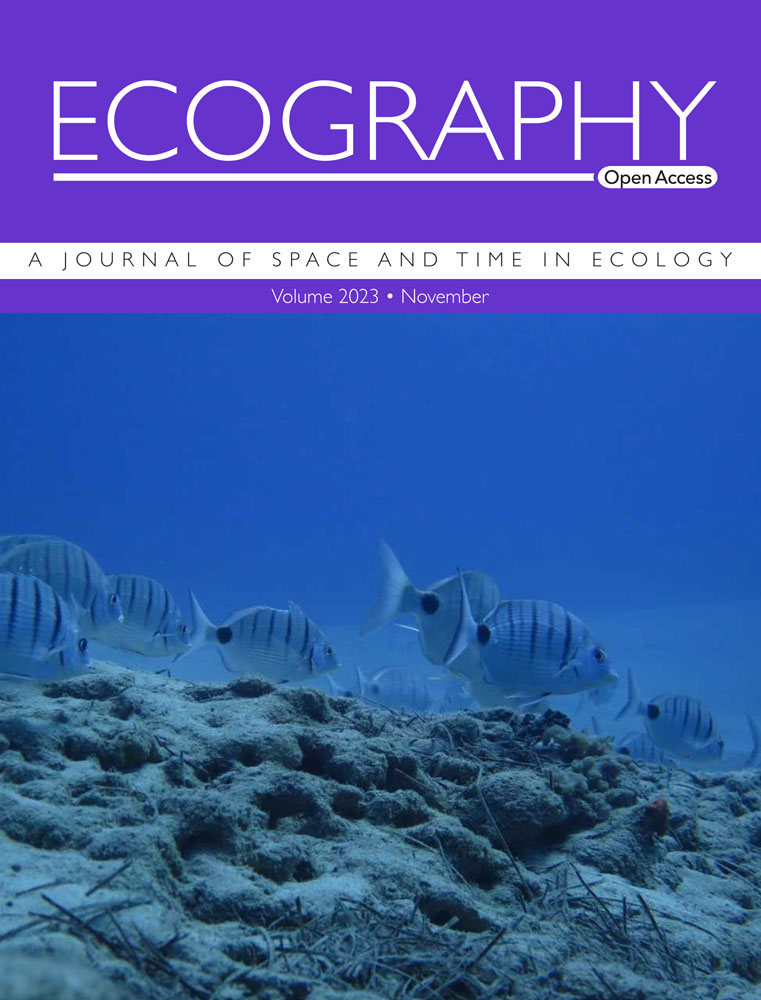Combined effects of temperature change and natural habitat on the abundance of arthropod trait syndromes in agroecosystems
IF 5.4
1区 环境科学与生态学
Q1 BIODIVERSITY CONSERVATION
引用次数: 0
Abstract
Land‐use changes and climatic changes are two entwined stressors on ecosystems. Studies on such interactions often focus on species‐level or region‐specific responses, but fewer have examined differences in responses based on functional traits. Here we examine the influence of natural habitat cover and temperature change on the abundance of all arthropods and on the abundance of pollinator, pest and natural enemy trait syndromes (based on diet breadth, habitat breadth and dispersal mode) in arthropod communities within European agroecosystems. Using a previously compiled dataset along with historical climatic data, we found that all arthropods, diet generalist pollinators and habitat generalist pests were more abundant in sites with a high amount of natural habitat regardless of temperature changes experienced. For diet specialist pollinators, natural habitat and temperature change antagonistically influenced abundance; high amounts of natural habitat in landscapes appeared to mitigate the negative effects of increasing temperature extremes. Habitat specialist pest abundance was higher in sites that experienced greater increases in mean annual temperature, regardless of natural habitat cover. Natural enemies appeared to be more abundant in sites that experienced greater increases in temperature variation. For natural enemies that were flight‐dispersing and habitat generalists this was regardless of natural habitat cover, while for ground‐dispersing natural enemies, temperature change and high natural habitat cover appeared to benefit habitat generalists (ground beetles) and specialists (primarily spiders). Given the variability in responses we observed between different arthropods based on diet breadth, habitat specialism, dispersal ability and functional group, we conclude that functional approaches examining impacts of qualitatively different stressors can help inform future conservation actions or mitigation efforts.温度变化与自然生境对农业生态系统节肢动物性状综合征丰度的综合影响
土地利用变化和气候变化是两个相互交织的生态系统压力源。对这种相互作用的研究通常集中在物种水平或区域特异性反应上,但很少有研究基于功能性状的反应差异。在这里,我们研究了自然栖息地覆盖和温度变化对欧洲农业生态系统中节肢动物群落中所有节肢动物的丰度以及传粉者、害虫和天敌特征综合征(基于饮食宽度、栖息地宽度和传播模式)的丰度的影响。利用前期编制的数据集和历史气候数据,研究人员发现,无论温度变化如何,在自然栖息地数量较多的地点,节肢动物、饮食通用性传粉媒介和栖息地通用性害虫的数量都更丰富。对于饮食专门型传粉媒介,自然栖息地和温度变化对其丰度产生拮抗影响;景观中大量的自然栖息地似乎减轻了极端温度增加的负面影响。无论自然生境覆盖度如何,在年平均气温上升幅度较大的地点,生境专用害虫的丰度较高。在温度变化幅度较大的地点,天敌似乎更丰富。对于飞行分散型和栖息地通用性的天敌来说,这与自然栖息地覆盖率无关,而对于地面分散型天敌来说,温度变化和高自然栖息地覆盖率似乎有利于栖息地通用性天敌(地甲虫)和专用性天敌(主要是蜘蛛)。考虑到我们观察到的不同节肢动物在饮食宽度、栖息地特殊性、扩散能力和功能群体之间的反应差异,我们得出结论,通过功能方法研究质量不同的应激源的影响可以帮助为未来的保护行动或缓解努力提供信息。
本文章由计算机程序翻译,如有差异,请以英文原文为准。
求助全文
约1分钟内获得全文
求助全文
来源期刊

Ecography
环境科学-生态学
CiteScore
11.60
自引率
3.40%
发文量
122
审稿时长
8-16 weeks
期刊介绍:
ECOGRAPHY publishes exciting, novel, and important articles that significantly advance understanding of ecological or biodiversity patterns in space or time. Papers focusing on conservation or restoration are welcomed, provided they are anchored in ecological theory and convey a general message that goes beyond a single case study. We encourage papers that seek advancing the field through the development and testing of theory or methodology, or by proposing new tools for analysis or interpretation of ecological phenomena. Manuscripts are expected to address general principles in ecology, though they may do so using a specific model system if they adequately frame the problem relative to a generalized ecological question or problem.
Purely descriptive papers are considered only if breaking new ground and/or describing patterns seldom explored. Studies focused on a single species or single location are generally discouraged unless they make a significant contribution to advancing general theory or understanding of biodiversity patterns and processes. Manuscripts merely confirming or marginally extending results of previous work are unlikely to be considered in Ecography.
Papers are judged by virtue of their originality, appeal to general interest, and their contribution to new developments in studies of spatial and temporal ecological patterns. There are no biases with regard to taxon, biome, or biogeographical area.
 求助内容:
求助内容: 应助结果提醒方式:
应助结果提醒方式:


